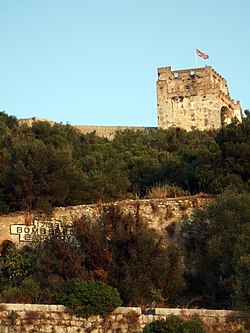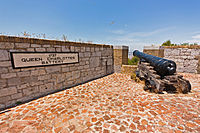Difference between revisions of "Moorish Castle"
(Created page with '{{Infobox castle |name=The Moorish Castle |territory=Gibraltar |picture=The Moorish Castle.jpg |picture caption=The Moorish Castle's Tower of Homage in Gibraltar |latitude = 36.1…') |
m (clean up, typos fixed: Indeed → Indeed,) |
||
| Line 18: | Line 18: | ||
==History== | ==History== | ||
[[File:Queen Charlottes Battery.jpg|thumb|left|200px|Queen Charlotte's Battery]] | [[File:Queen Charlottes Battery.jpg|thumb|left|200px|Queen Charlotte's Battery]] | ||
| − | The Moorish occupation is by far the longest occupation in Gibraltar's recorded history, having lasted from 711 to 1309 and then again from 1350 to 1462; a total of 710 years. <ref>{{Cite web | url=http://www.guide-to-castles-of-europe.com/moorish-castle.html | title=Moorish Castle | publisher=Guide to the Castles of Europe | accessdate=2012-09-13}}</ref> Indeed it was at Gibraltar that the Moors first set foot in Europe in 711. | + | The Moorish occupation is by far the longest occupation in Gibraltar's recorded history, having lasted from 711 to 1309 and then again from 1350 to 1462; a total of 710 years.<ref>{{Cite web | url=http://www.guide-to-castles-of-europe.com/moorish-castle.html | title=Moorish Castle | publisher=Guide to the Castles of Europe | accessdate=2012-09-13}}</ref> Indeed, it was at Gibraltar that the Moors first set foot in Europe in 711. |
The Moorish conquest of Spain was led by Tarik ibn Ziyad and Musa ibn Nusayr, the former of whoim gave his name to the rock: ''Jebel Tariq'': Gibraltar. This therefore became the stepping-stone to the conquest of Spain and part of France over a stunning campaign of just twenty-two years, no mean task considering the distances involved and the mountainous terrain of Iberia.<ref>{{Cite web | url=http://www.gibraltar.gov.gi | title=Information on the Moorish Castle Complex | publisher=Government of Gibraltar | accessdate=2007-02-13}}</ref> | The Moorish conquest of Spain was led by Tarik ibn Ziyad and Musa ibn Nusayr, the former of whoim gave his name to the rock: ''Jebel Tariq'': Gibraltar. This therefore became the stepping-stone to the conquest of Spain and part of France over a stunning campaign of just twenty-two years, no mean task considering the distances involved and the mountainous terrain of Iberia.<ref>{{Cite web | url=http://www.gibraltar.gov.gi | title=Information on the Moorish Castle Complex | publisher=Government of Gibraltar | accessdate=2007-02-13}}</ref> | ||
Revision as of 19:02, 30 January 2016
| The Moorish Castle | |
|
Gibraltar | |
|---|---|
 The Moorish Castle's Tower of Homage in Gibraltar | |
| Location | |
| Location: | 36°8’38"N, 5°20’59"W |
| History | |
| Built c 711 | |
| Information | |
| Condition: | Partially ruined |
| Owned by: | Government of Gibraltar |
The Moorish Castle is the name given to a Medieval fortification in Gibraltar, made up of various buildings, gates, fortified walls and its most dominant features, the Tower of Homage and the Gate House. Part of the castle itself also housed HM Prison of Gibraltar until it was relocated in 2010.[1]
The Tower of Homage is clearly visible to all visitors to Gibraltar, not only because of its striking construction but also because of its dominant and strategic position. Although sometimes compared to nearby alcazars in Spain, the Moorish Castle in Gibraltar was constructed by the Marinid dynasty, making it unique in the Iberian Peninsula.[2]
History
The Moorish occupation is by far the longest occupation in Gibraltar's recorded history, having lasted from 711 to 1309 and then again from 1350 to 1462; a total of 710 years.[3] Indeed, it was at Gibraltar that the Moors first set foot in Europe in 711.
The Moorish conquest of Spain was led by Tarik ibn Ziyad and Musa ibn Nusayr, the former of whoim gave his name to the rock: Jebel Tariq: Gibraltar. This therefore became the stepping-stone to the conquest of Spain and part of France over a stunning campaign of just twenty-two years, no mean task considering the distances involved and the mountainous terrain of Iberia.[4]
The strategic importance of Gibraltar rose in the last years of the Moorish rule, since it became, after the successful conquest by the Christians of all the Guadalquivir valley, one of the key elements in the communication between the Kingdom of Granada and the Moorish domains in the North of Africa.
The construction of the Moorish Castle was commenced in the 8th century AD (possibly even in 711) but there is no record of when it was completed. Its walls enclosed a considerable area reaching down from the upper part of the Rock of Gibraltar down to the sea. The most conspicuous parts of the Castle now remaining are the upper tower, or Tower of Homage, together with various terraces and battlements below it, and the massive Gate House, with its cupola roof.[5]
After 710 years, Moorish rule ended in 1462 when the Spaniards took Gibraltar and its castle, to provide a fortress threatening Granada, the last Moorish kingdom. The Spanish interlude lasted 242 years before Britain captured Gibraltar in 1704.
The Tower of Homage
The Tower of Homage is the highest tower of the Islamic period in the Iberian Peninsula, and the Castle's Qasbah is the largest in the area. The Castle itself played a prominent part in the Arab conquest of the Iberian Peninsula, which overran a large portion of it in two years - an invasion which led to Arab domination over part of Europe for over seven centuries. It is therefore of great heritage significance not only to Gibraltar and Iberia but also to Europe.
The present Tower of Homage, and most of what is visible today of the Castle, was rebuilt during the second Moorish period of occupation in the early 14th century, after its near destruction during a reconquest of Gibraltar by the Moors following a brief reoccupation by Spain (from 1309 to 1333).[5]
Present day
Today the Moorish Castle is one of the major tourist attractions of Gibraltar and it features on the reverse of the 1995 design (still in circulation) for the Gibraltarian £5 banknotes.[6]
The term Moorish Castle is also used locally when referring to the residential area surrounding the Castle, which houses the Moorish Castle Estate.
Part of the castle itself also housed HM Prison of Gibraltar until it was relocated in 2010.[1]
References
- ↑ 1.0 1.1 Mascarenhas, Alice (2010-09-01). "GATES CLOSE, ‘WINDY’ PRISON OPENS FOR BUSINESS". The Gibraltar Chronicle. The Gibraltar Chronicle. Archived from the original on 2010-09-01. http://www.webcitation.org/5sQXDDEHx. Retrieved 2010-09-01.
- ↑ "The Heritage of Gibralter: A Reply". CAM Bulletins. Commonwealth Association of Museums. 05 1998. http://www.maltwood.uvic.ca/cam/publications/CAM_bulletins/004_heritage_of_gibralter.html. Retrieved 2012-09-10.
- ↑ "Moorish Castle". Guide to the Castles of Europe. http://www.guide-to-castles-of-europe.com/moorish-castle.html. Retrieved 2012-09-13.
- ↑ "Information on the Moorish Castle Complex". Government of Gibraltar. http://www.gibraltar.gov.gi. Retrieved 2007-02-13.
- ↑ 5.0 5.1 "Gibraltar Heritage Trust History of The Moorish Castle". http://www.gib.gi/heritage/castle.html#galley. Retrieved 2007-02-13.
- ↑ "World Paper Money - Image of the reverse of a 1995 £5 Gibraltar banknote" (JPEG). Will's Online World Paper Money Gallery. http://www.currencymuseum.net/images/gibraltar25-1995r.JPG. Retrieved 2012-09-13.
Outside links
| ("Wikimedia Commons" has material about Moorish Castle) |

